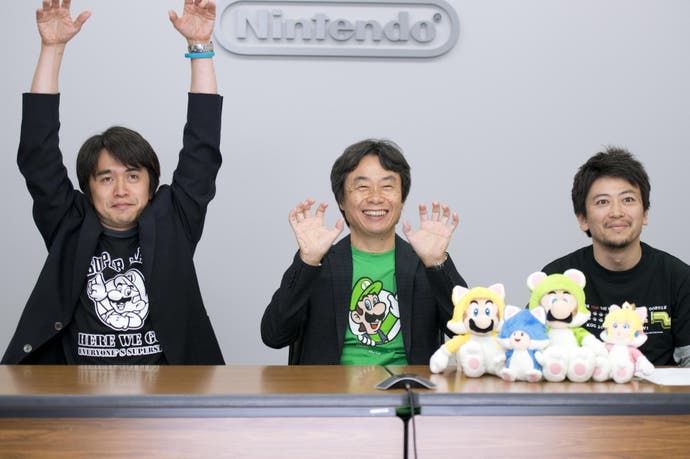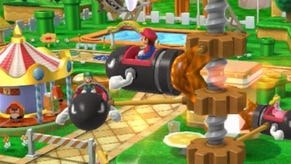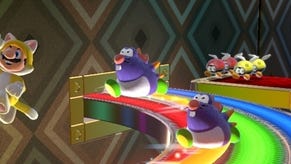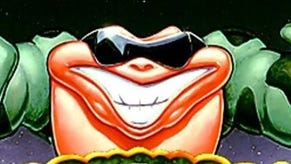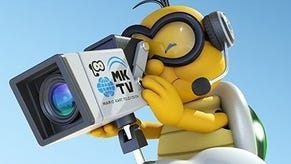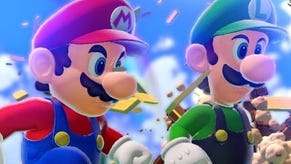Touring the World with Miyamoto
Nintendo's finest designers guide us around Super Mario 3D World.
Super Mario video games have always rewarded curiosity. It is perhaps this trait that Shigeru Miyamoto's series - now close to 30 years old - has valued in its players above all others, a tribute perhaps, to the designer's oft-repeated childhood experience of clutching a lantern in order to explore the local caves on the outskirts of Sonobe, the small Japanese town in which he grew up. It's also a trait that Miyamoto has seemingly passed on to his junior staff at Nintendo EAD Tokyo, within whose secretive, never-exposed walls some of the greatest video games of the past decade have been built.
"One of our younger development staff told me that they wanted to know what went on when Mario entered a pipe," says Miyamoto, referring to the yawning green pipes that punctuate the ground in Mario games which the plumber has always used as a way to access secret sewers. "They were curious as you could never see what was going on in there." The result of the resulting philosophical debate between the team is that Super Mario 3D World features transparent pipes, through which Mario and his three playable accomplices - brother Luigi, princess Peach and her attendant butler Toad - can now be seen to slip and slide on their bellies, arms outstretched like diving Supermen.

On this cold October morning, the German sky a unanimous grey, Super Mario 3D World has inspired additional transparency for the curious. A handful of journalists have been invited to Nintendo's Frankfurt headquarters for a video conference call with Miyamoto, the game's producer Yoshiaki Koizumi and its director Kenta Motokura. The three men - without whom it is unlikely that Nintendo would exist in anything like its current form (and without anything like its enviable reputation) - sit coyly in a formal line-up in Nintendo EAD's offices, peeking over the fuzzy heads of three Mario plushies which smile unblinkingly from within cat costumes.
Miyamoto thrives in this setting. One-on-one he can come across as introspective, closed in some way, as if bewildered by the idea that someone might be interested in his life and work. But, as anyone who has watched his spirited performances on stage when announcing new Nintendo titles will know, with an audience (and that attendant safety in numbers) he feels comfortable enough to let his exuberant, playful side shine. He is, in some fundamental way, a shy performer (indeed, as a child he would stage performances with homemade puppets for his family) something he reveals time and again in this sort of context.
For example, when the conversation turns to cat Mario - a transformation that occurs in the game when the character dons this, the latest ability-enhancing costume to be added to the plumber's increasingly fetishist wardrobe - Miyamoto lets his hands dangle tightly together from his chest, mimicking the animal's paws. As the room falls silent, he licks his lips, pretends to clean his cheek and then, when the act is finished and he notes our giggling approval, his features bloom into a broad smile.
When he poses for photos at the end of the conference call (a strange scenario born of this particular moment in humankind's technological trajectory: photographing a phone call relayed on a television screen) he opens his suit jacket and points posingly at his pea-green Luigi t-shirt, no doubt worn to remind us that we are speaking in this, the year of Luigi. With an audience, Miyamoto comes to playful life. You may not get to know him here, but you can experience a warm wit that, despite being squeaky clean, is also endlessly attractive.
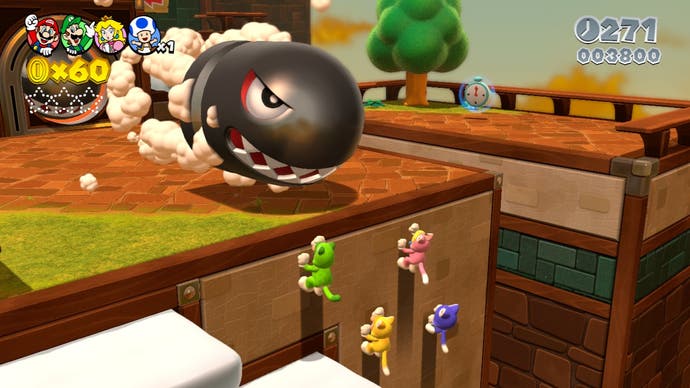
This quality extends from the man to his work. "He approaches games playfully," Will Wright, the creator of the Sims and Spore, once said of Miyamoto. "This seems kind of obvious, but most people don't." Indeed, Koizumi later tells me how his boss, now 60, would get down on all fours during Super Mario 3D World's development to demonstrate how he wanted cat Mario to move around the screen. It's this infectious, childlike quality to Miyamoto's manner that translates to his games as it's picked up upon by the directors and producers and handed down to everybody in the team, infusing the game with his character, philosophical view of video games and, beyond that, maybe even his approach to life.
Take Super Mario 3D World, for example, a game in which playful touches abound. On the world map, the hub screen whose layout nods towards 1990's Super Mario World, you can now move freely around the landscape - a first for the series. Walk through the tall grass or flowerbeds and you might kick up some bonus coins or extra lives. Then each stage itself is filled with transparent secrets, which only shimmer to reveal themselves when you ground stomp nearby, blow onto the Wii U controller's microphone, or hungrily rub its touchscreen like a scratch card. One new enemy, the long-necked Conkdor bird, attacks by slamming its beak downwards. If it misses you and hits the ground, the sunglasses it's wearing will fall from its nose.
There's more at every turn: play with friends (the game offers drop-in drop-out multiplayer for up to four players) and, at the end of each stage the player who won the most points is given a crimson and gold crown to wear during the next stage. It offers no bonus other than a sense of aesthetic dominance. Delightfully, other players can knock the crown from their rival's head and wear it themselves.
"Super Mario is fundamentally a game about jumping. The ability for the player to climb seems to challenge the core [of the series]. But I think we've found a way to implement that doesn't cause harm."
Shigeru Miyamoto
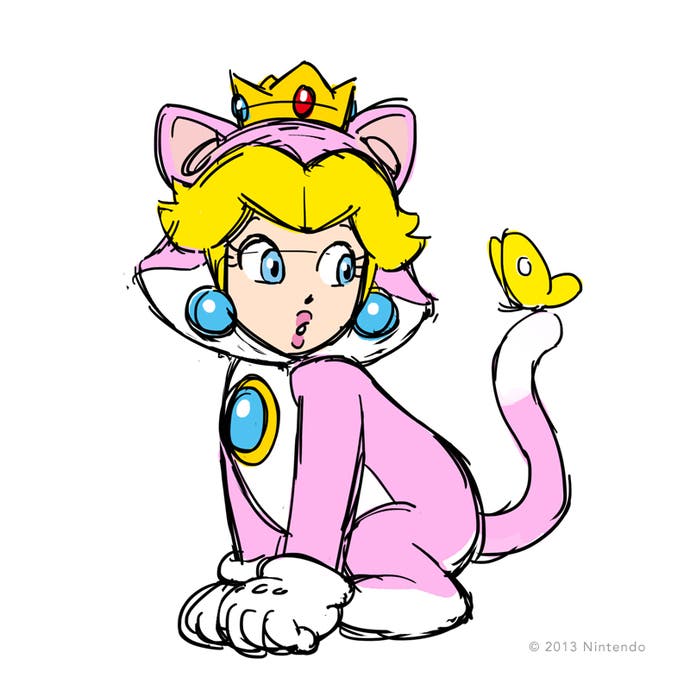
Touch a plain patch of grass on the Wii U touchpad and flowers will sprout and blossom from under your finger. In the winter stages you can trace shapes in the snow, or tap the blanket of flakes from the trees. These are non-ludic touches, strictly speaking, in that they do nothing to affect play. And yet, these are the details that elevate Nintendo EAD's work so far above its peers and rivals, the magical and indefinable difference. Miyamoto and his protégées (Koizumi and Motokura have worked with Miyamoto for decades) approach games playfully.
Super Mario 3D World has been accused by some as demonstrating a lack of ambition on developer Nintendo's part. In name, it's pitched as a sequel to 2011's Super Mario 3D Land - a fine lineage, to be sure, but perhaps not the singular expression that Wii U owners were hoping might come to define their new console. But to dismiss the game as lazy, or a half-measure of creativity is to do the game grand injustice. The team, visibly tired on the conference call screen, has evidently poured its all into this game. "It was a very stressful time," says Miyamoto. "We're relieved that we were able to finish everything, but also we very much enjoyed developing the game."
The decision to build upon Super Mario 3D Land's blueprints hasn't been inspired by a lack of invention or creative exhaustion. Rather, it's because right now Nintendo EAD believes that this style of 'action Mario game' (as they refer to the mainline Super Mario titles) offers the best possible way for both veterans and newcomers to play together.
"Super Mario 64 was a key turning point in the history of Super Mario," explains Miyamoto (before adding, with typical modesty: "It was a good game but we were not quite able to achieve something that was both fun and easy for both beginners and advanced players.") Miyamoto admits that the Super Mario Galaxy games, which tried to find a better balance for novice and expert, still skewed towards the latter kind of player. "But with Super Mario 3D Land we found the spirit of the original games which were easy for beginners but allowed for advanced play," he says, "all within the 3D environment."
Inclusivity has been Nintendo's guiding principle since the Wii console's launch, and Super Mario 3D World continues the theme. Central to this design thrust is the cat costume, which is much more than a mere aesthetic bolt on. Following a cat transformation your character is able to climb walls and attack enemies using a swipe of the claws. The upgrade is more significant than those we've seen in past Mario games. Now, a player can progress through a level without the need to judge jumps, or line up attacks on enemies: a simple swipe of the claws will aid progression.
Koizumi admits that this is a concession to newcomers who may have, in the past, struggled with lining up Mario's familiar ground-pound move to land on a foe's head in 3D space.
"The cat costume is the key to this game," he says. "It makes it easier for beginners to make it through levels and get to the goal posts. But advanced players can use the transformation to perform acrobatic moves and impossible feats. For example, you can perform horizontal jumps from one wall to the other - a new feature that advanced players will enjoy." Miyamoto agrees: "Super Mario is fundamentally a game about jumping. So this addition might seem strange: the ability for the player to climb seems to challenge the core [of the series]. But I think we've found a way to implement that doesn't cause harm."
Further experimentation comes in the form of a cherry pick-up, which duplicates the player's character so that they're simultaneously controlling two avatars on screen. This allows Nintendo's designers to create puzzles traditionally only used in multiplayer games, such as where one character must stand on a pressure pad in order to allow another to continue through an opened door. Every new cherry collected adds another duplicate to the screen resulting in some intensely funny moments, especially when other players are running through and around the swarm of duplicates.
The four main playable characters, far from being mere repainted copies of one another, have their own strengths and weaknesses. Mario is the evergreen all-rounder, of course, while sibling Luigi, being taller and slimmer, is able to jump a little higher. Toad scurries about at a far quicker pace than the rest, while Princess Peach - who here makes her debut in the mainline 'action Mario' lineage - is able to use her billowing dress to float from platform to platform.

"When Miyamoto and Koizumi were working on Super Mario Galaxy 2 we discussed the topic of empathy," explains Motokura, whose first job at Nintendo was designing plants in Pikmin. "I think in the design of the characters we aimed for achieving this empathy. When it comes to Peach, I think many players will want to play as her; but I don't think that's gender specific. Remember, we've had her as a playable character in Super Mario Kart for a while now."
As well as helping to generate empathy, the range of characters - all of which are unlocked from the beginning of the game - also subtly changes the way in which the game is played. "Players can choose type that best fits their playing style and it's also fun to play same course with different characters to see how it plays differently," says Motokura.
Despite the abundance of creative flourishes in the game, experienced players hoping to be wowed again by Nintendo's seemingly endless ability to re-paint the Mario myth in new forms and styles may find the approach over-familiar. Ostensibly, this is a celebration of Mario's heritage, albeit with a few cherry pick-ups on top, rather than a fresh direction, in the way that Koizumi's Super Mario Galaxy was. Mario games have traditionally been pioneering in nature, not only in terms of their scope - Land, to World to Galaxy - but also in terms of their vision. Super Mario 3D Land is a return to the Super Nintendo classic, kicked into 3D while drawing in the great many lessons in designing inclusive multiplayer learned in the intervening years. In this way it aims to provide a bold, communal celebration of the past thirty years, during which Mario has defined and redefined video games time and again. In this way it promises to, once again, reward the curious.
This article was based on a press trip to Nintendo's offices in Frankfurt. Nintendo paid for travel and accommodation.
